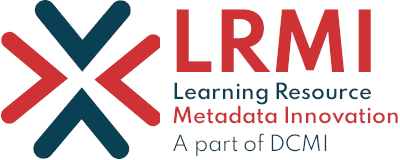LRMI™ Alignment Type Vocabulary
| Title | LRMI Alignment Type Vocabulary |
|---|---|
| Creator: | LRMI Task Group (DC-Education Community) |
| Editors: | Phil Barker Stuart Sutton |
| Date Issued | 2017-12-20 |
| Release History | https://www.dublincore.org/specifications/lrmi/concept_schemes/release-history/ . |
| Scheme Identifier | http://purl.org/dcx/lrmi-vocabs/alignmentType/ |
| RDF/ttl encoding | http://dublincore.org/vocabs/alignmentType.ttl |
| Status: | DCMI Community Specification |
| Description: | The LRMI Alignment Type Vocabulary defines some possible relationships between a learning resource and a node in an educational framework. It is designed to provide values for the lrmi alignmentType property. |
| License | Creative Commons Attribution 4.0 International License (CC:BY 4.0). |
Table of Contents 
1. Introduction and Definitions
LRMI Alignment Type Vocabulary is a small vocabulary intended to provide values for the LRMI alignmentType property in learning resource description and web markup. It is one of several such vocabularies from LRMI. For a general description of the approach common to all LRMI concept schemes see the LRMI Concept Schemes page. As with all LRMI concept schemes, the intention is to provide a small number of broad, top-level concepts. Users who need to classify against more specific concepts are encouraged to declare these concepts using SKOS and to map them to the appropriate LRMI concept using skos:broadMatch.
The vocabulary is defined as a Simple Knowledge Organization System (SKOS) Concept Scheme. A subset of terms from the table shown on the LRMI Concept Schemes page is used in defining the concept scheme and its associated concepts. These terms are drawn from the SKOS and other namespaces identified in Section 2.
The machine-readable RDF/ttl encoding includes a German translation.
2. Namespaces and Scheme Identifiers
The namespaces in the table below are referenced in the definitions of the concept schemes and their component concepts:
| Prefix | IRI | |
|---|---|---|
| dc | http://purl.org/dc/elements/1.1/ | DCMI Metadata Element Set |
| dct | http://purl.org/dc/terms/ | DCMI Metadata Terms |
| rdf | http://www.w3.org/1999/02/22-rdf-syntax-ns# | RDF 1.1 Concepts vocabulary |
| rdfs | http://www.w3.org/2000/01/rdf-schema# | The RDF Schema vocabulary |
| skos | http://www.w3.org/2004/02/skos/core# | Simple Knowledge Organization System |
| xsd | http://www.w3.org/2001/XMLSchema# | XML Schema (datatypes) |
The IRI for the LRMI Alignment Type Concept Scheme, http://purl.org/dcx/lrmi-vocabs/alignmentType/, is abbreviated as the prefix alignment. Thus alignment:assesses stands for http://purl.org/dcx/lrmi-vocabs/alignmentType/assesses.
3. Alignment Type Vocabulary
| URL: | http://purl.org/dcx/lrmi-vocabs/alignmentType/ |
| Type: | SKOS:ConceptScheme |
| Title: | LRMI Alignment Type Vocabulary |
| Description: | A concept scheme that defines the types of relationships between a learning resource and a node in an educational framework. |
| Creator: | LRMI Task Group (DCMI) |
| Date Created: | 2017-03-01 |
| Date Modified: | 2017-12-20 |
| License: | http://creativecommons.org/licenses/by/4.0/ |
Assesses
| URL: | http://purl.org/dcx/lrmi-vocabs/alignmentType/assesses |
| Label: | assesses |
| Definition: | The learning resource being described may be used to assess the competency being referenced. |
| Source: | Based on Common Education Data Standards (CEDS): https://ceds.ed.gov/element/000869#Assesses. |
Complexity Level
| URL: | http://purl.org/dcx/lrmi-vocabs/alignmentType/complexityLevel |
| Label: | complexity level |
| Definition: | The point in the framework being referenced defines a level or range that measures the difficulty or challenge presented by the learning resource being described. |
| Scope Note: | Example frameworks include, but are not limited to, Bloom's Taxonomy, Norman Webb's Depth of Knowledge (DOK), Biggs' SOLO taxonomy, Lexile and Quantile frameworks by MetaMetrics. |
Educational Level
| URL: | http://purl.org/dcx/lrmi-vocabs/alignmentType/educationalLevel |
| Label: | educational level |
| Definition: | The point in the framework being referenced defines a level or stage within an education system for which the resource being described is intended or useful. |
| Source: | Based on Common Education Data Standards (CEDS): https://ceds.ed.gov/element/000869#EducationalLevel. |
Educational Subject
| URL: | http://purl.org/dcx/lrmi-vocabs/alignmentType/educationalSubject |
| Label: | educational subject |
| Definition: | The point in the framework being referenced defines the subject context of the learning resource being described. |
| Scope Note: | The educational subject identifies the educational context of the resource being described such as "math", "science", "physics", "algebra", and "English language arts". To identify the particular topic(s), or aboutness, of the resource being described--e.g., "Pythagorean theorem", "Abraham Lincoln", "Ayers Rock"--use the schema.org/about property. |
| Source: | Based on Common Education Data Standards (CEDS): https://ceds.ed.gov/element/000869#EducationalSubject. |
Prerequisite
| URL: | http://purl.org/dcx/lrmi-vocabs/alignmentType/prerequisite |
| Label: | prerequisite |
| Definition: | The competency being referenced is a learning prerequisite to the effective outcome of the learning resource being described. |
| Source: | Based on Common Education Data Standards (CEDS): https://ceds.ed.gov/element/000715. |
Reading Level
| URL: | http://purl.org/dcx/lrmi-vocabs/alignmentType/readingLevel |
| Label: | reading level |
| Definition: | The point in the framework being referenced defines a level or range of reading ability expected for a person using the learning resource being described. |
| Scope Note: | Example frameworks include, but are not limited to, Lexile Framework by MetaMetrics, ATOS by Renaissance Learning, Degrees of Reading Power (DRP) by Questar Assessment, Flesch-Kincaid (public domain), Reading Maturity by Pearson Education, SourceRater by Educational Testing Service, Easability Indicator by Coh-Metrix, and the Oxford Reading Tree levels from Oxford University Press. |
| Source: | Based on Common Education Data Standards (CEDS): https://ceds.ed.gov/element/000869#ReadingLevel. |
Teaches
| URL: | http://purl.org/dcx/lrmi-vocabs/alignmentType/teaches |
| Label: | teaches |
| Definition: | The learning resource being described may be used to teach the competency being referenced. |
| Source: | Based on Common Education Data Standards (CEDS): https://ceds.ed.gov/element/000869#Teaches. |
Page maintained by the LRMI Task Group.
